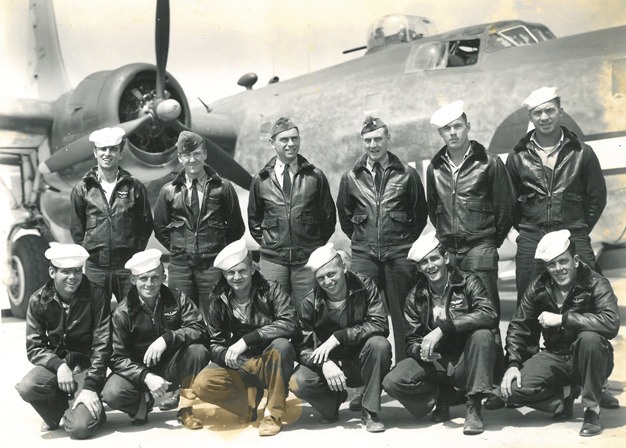For Islander Art Jacobson, a Bronze Star for his meritorious service in World War II came 60 years late.
His memories of those harrowing days have faded. He is 97 now, but his bearing and reserve are military. A hip replacement at age 92 has slowed him, but not too much. He still walks an hour each day at 10 a.m.
He is not too sure what the fuss is about those months at war. You did what you were told and what you had to do. In the days after the attack on Pearl Harbor, there was no time for questions.
The career Navy man was born in Tacoma in 1915. He was always interested in flying, he said. Mechanically minded, he helped out at the service stations that his father owned around town. In high school, he and fellow students built a working glider. At 16, he was flying whenever he could afford to pay for the fuel. Later, he attended the University of Washington when he had money, working between semesters in the years after the stock market fell. Finally, he enlisted in the Navy and was sent to Florida for flight training in the late 1930s.
His first assignment was Hawaii. He was later sent to the Philippines in the months leading up to the attack on Pearl Harbor. He piloted amphibious PBY Catalinas.
The PBY was the Navy’s “eyes in the sky” for the Pacific fleet. Their job was to search for, and locate, an enemy fleet hundreds of miles away from the fleet before it could attack.

The Navy and President Roosevelt were keen to know what the Japanese were up to, and the PBY was the plane to do it. It had the range and ability to go to where the Japanese were and report on them. It was slow, not very maneuverable and did not have self-sealing fuel tanks or bulletproof armor for the crew or pilots. Regardless of its short- comings, it was the only plane that the Navy had capable of doing the job.
In the hours and days after the attack on Pearl Harbor, the Japanese and their quick and deadly Zero fighters turned their attention to the American bases in the Philippines. But after months of patrolling the Islands, the PBY pilots knew the territory well. They knew places where they could hide. They had learned to duck into the clouds.
But there were many casualties. The PBYs were regularly strafed with bullets. The men kept broken pencils with them to plug the bullet holes in the plane.
Bob Bergstrom, the son of Jacobson’s good friend and fellow Navy pilot, Captain Edward W. Bergstrom, has written extensively about the role of PBYs in the war. He was responsible for WWII PBY crews and pilots receiving the Bronze Star awards recently, including his father, now deceased, and his father’s old friend, Jacobson.
In a recent story on the Orders and Medals Society of America website, Bergstrom described what the PBY fliers faced against the quicker and superior Zeros.
“There were no real navigation aids, no maps. It was celestial navigation and dead reckoning at its best. The pilots observed what was around them. Sometimes they would fly close to the sea to check the direction of the wind on the waves,” he wrote.
When asked if he was ever afraid during these arduous patrols, Jacobson took a long pause. “Only just scared to death,” he said.
The Zeros decimated U.S. bases and their aircraft in the Philippines. The pilots and crews were finally forced south and ended up in the Dutch East Indies after a series of marathon flights. They went on to Australia, where they only had the clothes on their backs when they arrived. They were exhausted and hungry. Within a few days, they were put on a ship and sent back to the states.
After a short break stateside, Jacobson and other PBY pilots were sent to the Aleutian Islands in Alaska, where the Japanese had set up shop looking to extend their reach into North America.
The extreme weather was hard on both the planes and the men who lived along the shore in canvas tents.
The Japanese had invaded the Island of Kiska and bombed Dutch Harbor. The PBYs were placed on almost round-the-clock missions. Any and all PBYs were ordered to make bombing runs on Kiska Harbor during their normal patrol. The missions sometimes lasted 24 hours. The PBYs had to avoid attacking fighters and then “dive bomb” the ships through breaks in the fog.
Many were lost.
Most just disappeared, Jacobson said. “We would never know what happened to them. They would just not come back.”
During all of this, a U.S. submarine went aground, leaving its crew stranded and vulnerable. Jacobson commanded three planes that went to pick up the men.
“It was foggy,” he remembered. “We had to fly just 50 feet off the water.”
They squeezed the additional men onto the already overloaded planes and slipped back over the waves.
At some point during the fighting in Alaska, Jacobson learned that he had been awarded the Distinguished Flying Cross. There was no fuss or ceremony. The Navy had mailed the medal to his mother at home in Tacoma.
Jacobson remained in the Navy for 35 years. Just after the war, he and his wife, Lois Jacobson, moved to a home on the South end, where they remain today. There they raised seven children. They now have 14 grandchildren and eight great-grandchildren. Lois Jacobson has taught piano on two grand pianos in the basement for many years.
The family owned a six-seat Piper Comanche airplane that they flew as far as South America. On one trip, they returned to Alaska, toting a motorcycle to get around.
Jacobson last flew the plane on his 90th birthday.
Bob Bergstrom contributed to this story.



